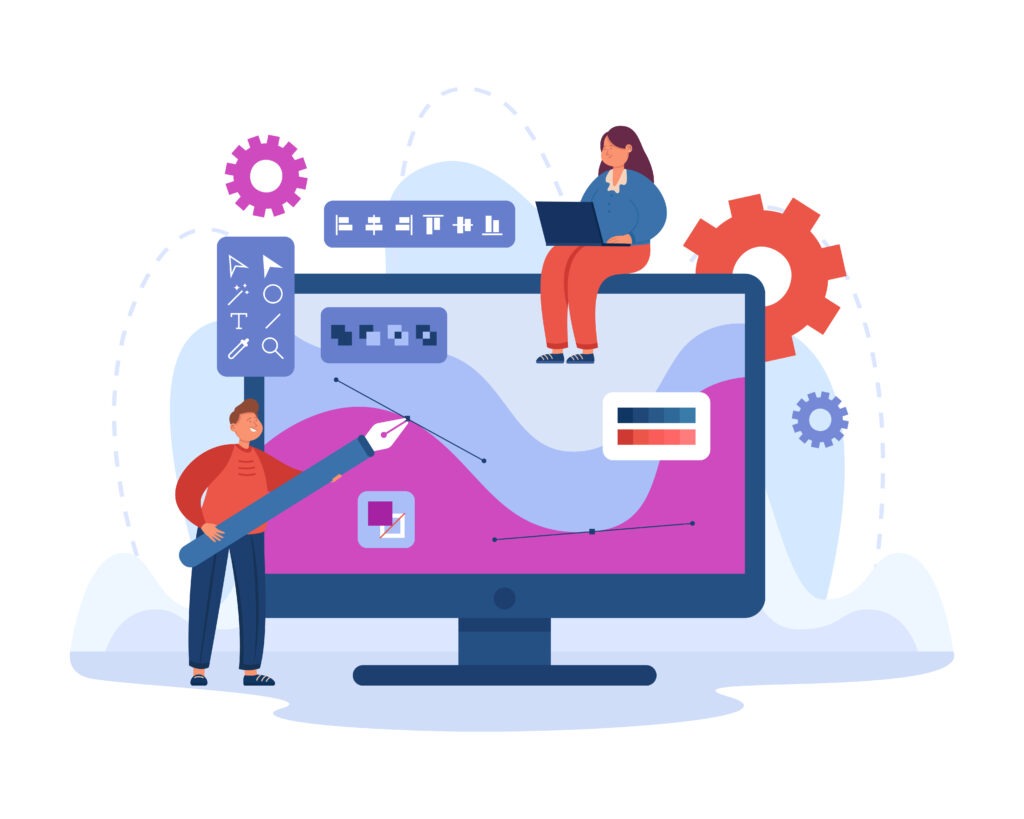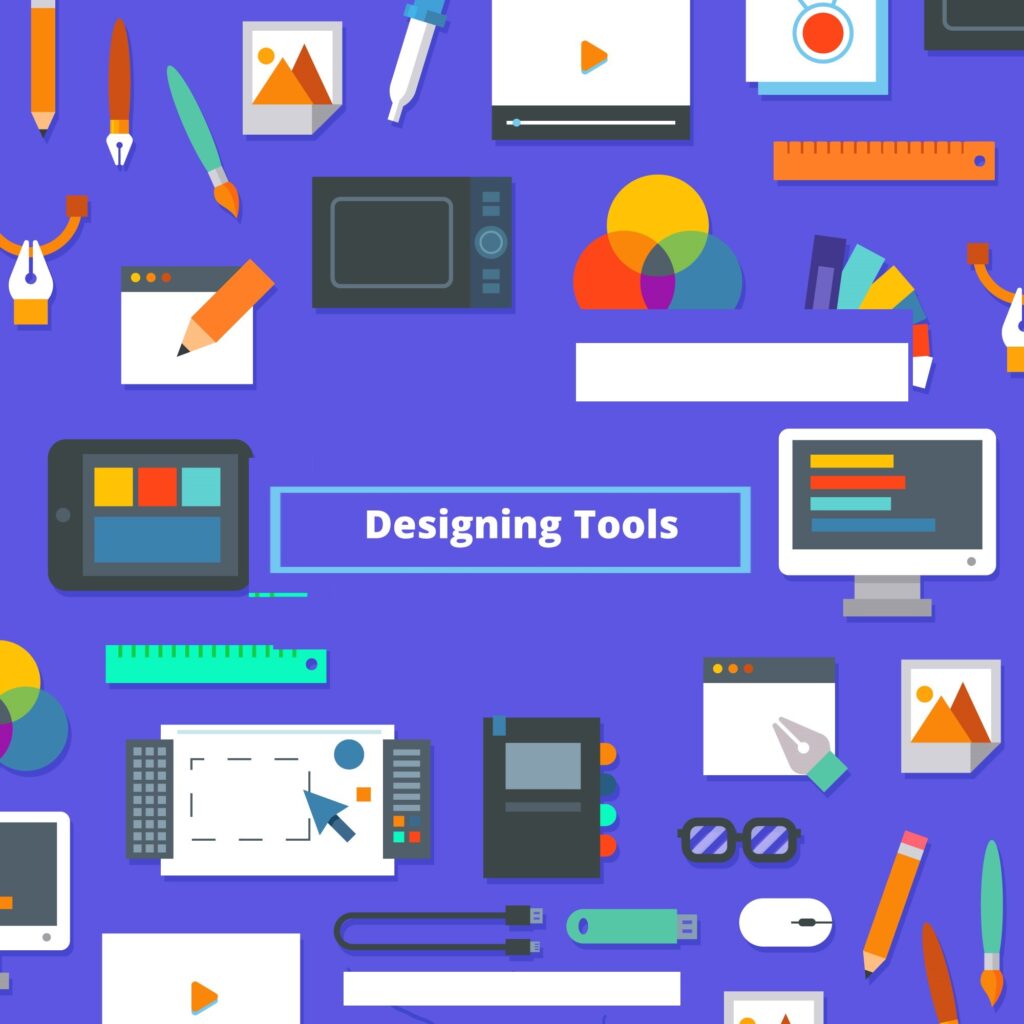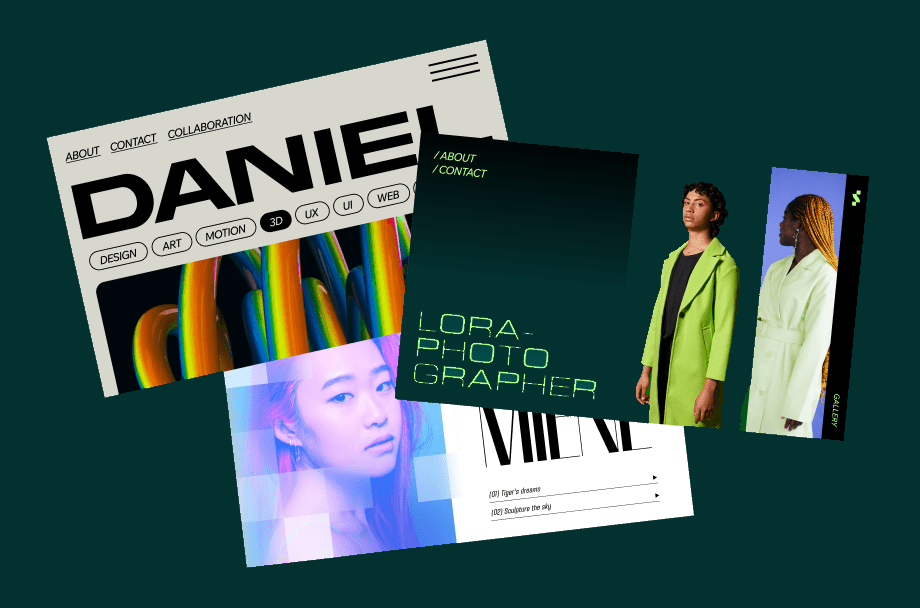
Table of Contents
I marched into my sophomore Design 101 class, brimming with confidence. Graphic design? I had it figured out.
I was itching to skip past the elementary stuff – colors, shapes, and those basic Photoshop tutorials – and dive straight into the heart of advanced design. How wrong I was. Graphic design turned out to be a complex beast, full of hidden depths.
It was like discovering an entirely new world, one layer at a time. Those simple concepts I thought I knew so well were actually the foundation for something much bigger. It was like peeling back an onion, and with each layer, I realized just how little I knew.
What is Graphic Design?

Graphic design is the art and practice of planning and projecting ideas and experiences with visual and textual content. In other words, it involves creating visual content to communicate messages. These messages can be as simple as a business card or as complex as an entire website.
Graphic designers use a combination of typography, imagery, color, and layout techniques to create visual compositions. These compositions can be seen in print media like posters and magazines, digital media like websites and apps, and even in physical spaces like billboards and packaging.
The History of Graphic Design
To understand graphic design, it’s essential to appreciate its rich history. The field has evolved significantly over the years, influenced by cultural shifts, technological advancements, and changing societal needs.
Early Beginnings
Graphic design’s roots can be traced back to ancient civilizations. From cave paintings to hieroglyphics, humans have always used visual symbols to communicate. The invention of the printing press in the 15th century by Johannes Gutenberg marked a significant milestone, allowing for the mass production of printed materials and laying the groundwork for modern graphic design.
The Rise of Modern Graphic Design
The late 19th and early 20th centuries saw the birth of modern graphic design, with movements like Art Nouveau, Bauhaus, and De Stijl influencing design aesthetics. Designers like Paul Rand, Saul Bass, and Milton Glaser became pioneers, creating iconic works that defined the field.
The Digital Revolution
The advent of computers and the internet in the late 20th century revolutionized graphic design. Digital tools like Adobe Photoshop and Illustrator became industry standards, allowing designers to experiment with new techniques and push the boundaries of creativity. The rise of the internet also introduced new design challenges and opportunities, leading to the emergence of web and UI/UX design as key specializations.
Why Graphic Design?
Graphic design is vital in our visually driven world, converting ideas into compelling visual messages. It impacts everything from brand logos and website layouts to social media posts, shaping our interaction with information.
In 2024, graphic design is advancing with cutting-edge tools like AI and 3D rendering, blending creativity with technology to produce striking, immersive experiences. Its influence extends across brand identity, marketing, and user experience, making it crucial for effective communication.
With the rising demand for skilled designers, mastering graphic design is essential for making a significant impact and forging connections in today’s digital realm.
Core Principles of Graphic Design
At the heart of graphic design are a set of core principles that guide designers in creating effective and aesthetically pleasing compositions. Understanding these principles is crucial for any aspiring designer.
1. Balance
Balance refers to the distribution of visual elements in a design. There are two types of balance:
- Symmetrical Balance: Where elements are evenly distributed around a central axis, creating a mirror image on either side.
- Asymmetrical Balance: Where elements of varying visual weight are arranged in a way that creates a sense of equilibrium without mirroring.
Balance is essential for creating a harmonious design that feels stable and well-composed.
2. Contrast
Contrast involves the use of opposing elements, such as light vs. dark, large vs. small, or bold vs. thin. Contrast helps to create visual interest and draw attention to specific areas of a design. It also enhances readability and can guide the viewer’s eye through the composition.
3. Hierarchy
Hierarchy refers to the arrangement of elements in a way that signifies their importance. Designers use size, color, and placement to create a visual hierarchy, ensuring that the most critical information stands out. For example, in a poster, the headline is typically the largest text to grab attention, followed by subheadings and body text.
4. Alignment
Alignment ensures that elements in a design are placed in relation to each other in a way that creates a cohesive and organized look. Proper alignment helps to create order and structure, making the design more visually appealing and easier to navigate.
5. Repetition
Repetition involves using the same or similar elements throughout a design to create consistency and unity. Repetition can be seen in the use of color schemes, fonts, or shapes. It helps to reinforce a visual theme and can make the design more memorable.
6. Proximity
Proximity refers to the placement of related elements close to each other. Grouping related items together helps to create a sense of organization and makes it easier for the viewer to understand the relationship between different elements.
7. Color
Color is a powerful tool in graphic design, capable of evoking emotions, setting the tone, and guiding the viewer’s attention. Understanding color theory—how colors interact with each other and how they affect human perception—is crucial for creating effective designs.
Types of Graphic Design
Graphic design is a broad field that encompasses various specializations, each with its own unique focus and techniques. Here are some of the most common types of graphic design:
1. Visual Identity Design
Visual identity design focuses on creating the visual elements that represent a brand. This includes designing logos, color palettes, typography, and other visual components that create a brand’s overall look and feel. Visual identity designers work closely with branding specialists to ensure that the brand’s visual identity aligns with its values, mission, and target audience.
2. Marketing and Advertising Design
Marketing and advertising design involves creating visuals for promotional purposes. This can include everything from print advertisements and brochures to digital ads and social media graphics. The goal is to create compelling visuals that capture the audience’s attention and effectively communicate the brand’s message.
3. User Interface (UI) Design
UI design focuses on the look and feel of digital interfaces, such as websites, mobile apps, and software. UI designers create the visual components of these interfaces, including buttons, icons, menus, and layouts, ensuring that they are aesthetically pleasing and user-friendly.
4. User Experience (UX) Design
UX design goes hand in hand with UI design but focuses more on the overall user experience. UX designers conduct research to understand the needs and behaviors of users, then create wireframes and prototypes to design intuitive and efficient interfaces. The goal is to ensure that the user’s interaction with the product is smooth, enjoyable, and meets their expectations.
5. Packaging Design
Packaging design involves creating the visual elements of product packaging, including boxes, labels, and containers. Packaging designers must consider both aesthetics and functionality, ensuring that the packaging is visually appealing, protects the product, and communicates essential information to the consumer.
6. Motion Graphics Design
Motion graphics design involves creating animated visuals that bring static designs to life. This can include anything from animated logos and title sequences to explainer videos and social media content. Motion graphics designers use animation techniques to add movement, depth, and energy to their designs.
7. Environmental Design
Environmental design focuses on creating visual experiences within physical spaces. This can include designing signage, murals, exhibitions, and wayfinding systems for locations such as museums, offices, and public spaces. Environmental designers aim to enhance the overall experience of a space by integrating visual elements that complement the environment.
UI vs. UX Design
In the past, when people referred to “design,” they often meant graphic design. However, with today’s digital landscape dominated by interactive screens and devices, this understanding has evolved. Now, there are various types of design that can be confusing to those outside the industry.
Two important types you might have heard about are UX design and UI design.
UX Design
UX design, or user experience design, focuses on improving the overall experience users have with a product. It’s concerned with the structure and logic behind design elements to ensure they are user-friendly. UX designers aim to enhance a product’s usability and accessibility, making interactions smooth and enjoyable. They achieve this through analyzing user pain points and usability issues, both before and after a product is launched.
UI Design
UI design, or user interface design, deals with the interactive components of a product. This type of design is about anticipating users’ needs and creating elements like dropdown lists, toggles, and progress bars to facilitate their interactions. UI design extends beyond traditional graphic design to include any interactive elements, blending visual aesthetics with functionality to create an effective interface.
Essential Tools for Graphic Designers in 2024

As graphic design continues to evolve, so do the tools and technologies used by designers. In 2024, a wide range of software and hardware options are available to help designers bring their creative visions to life.
Software Tools
- Adobe Creative Cloud: Adobe’s suite of design tools, including Photoshop, Illustrator, InDesign, and XD, remains the industry standard for graphic designers. These tools offer a wide range of features for creating everything from digital illustrations to print layouts and web designs.
- Figma: Figma is a popular web-based design tool that allows for real-time collaboration on UI/UX design projects. It’s particularly favored by teams working on digital products, as it offers powerful prototyping and design features.
- Affinity Designer: Affinity Designer is a vector graphic design tool that offers a more affordable alternative to Adobe Illustrator. It’s known for its user-friendly interface and robust feature set, making it a popular choice for both beginners and professionals.
- Canva: Canva is an online design tool that’s ideal for beginners or those without formal design training. It offers a wide range of templates and design elements, making it easy to create everything from social media posts to marketing materials.
Hardware Tools
- High-Performance Computers: Graphic design requires powerful hardware capable of handling resource-intensive software. Designers typically use high-performance laptops or desktop computers with fast processors, ample RAM, and high-resolution displays.
- Graphics Tablets: Graphics tablets, such as those from Wacom, allow designers to draw directly on the screen with a stylus, offering a more natural and precise way to create digital illustrations and designs.
- Color Calibration Tools: Accurate color representation is crucial in graphic design, especially for print projects. Color calibration tools help designers ensure that the colors they see on their screen match the final printed product.
Trends Shaping Graphic Design in 2024
Graphic design is a dynamic field that is constantly evolving. As we move into 2024, several trends are shaping the way designers approach their work:
1. Minimalism and Simplicity
Minimalism continues to be a dominant trend in graphic design, with designers opting for clean, uncluttered layouts that focus on essential elements. This trend is driven by the need for clarity and ease of use, especially in digital interfaces.
2. Bold Typography
Typography is taking center stage in design, with bold, oversized fonts becoming increasingly popular. Designers are using typography not just as a means of conveying information but as a visual element that adds personality and impact to their designs.
3. 3D Design and Realism
Advances in 3D rendering technology are making it easier for designers to create hyper-realistic visuals that add depth and dimension to their work. 3D design is being used in everything from product packaging to digital interfaces, offering a new level of visual engagement.
4. Sustainability and Eco-Friendly Design
As environmental concerns continue to grow, more designers are prioritizing sustainability in their work. This includes using eco-friendly materials, designing for longevity, and creating visuals that promote environmental awareness.
5. Inclusivity and Diversity
Designers are increasingly focused on creating inclusive and diverse visuals that reflect the world we live in. This includes using a wide range of skin tones, body types, and cultural symbols in their designs, as well as ensuring that their work is accessible to people with disabilities.
6. AI and Automation
Artificial intelligence (AI) and automation are beginning to play a more significant role in graphic design. From AI-powered design tools that can generate layouts and color schemes to automation that streamlines repetitive tasks, these technologies are helping designers work more efficiently and creatively.
The Importance of a Strong Portfolio
For anyone looking to pursue a career in graphic design, building a strong portfolio is essential. Your portfolio is your visual resume, showcasing your skills, creativity, and unique style to potential clients or employers.

What to Include in Your Portfolio
- Diverse Range of Work: Include a variety of projects that demonstrate your versatility as a designer. This can include branding, web design, illustrations, packaging, and more.
- Case Studies: Provide context for each project by including case studies that explain the design process, the challenges you faced, and the solutions you implemented.
- Personal Projects: Don’t be afraid to include personal projects that showcase your creativity and passion for design. These can help set you apart from other designers.
- Updated Work: Regularly update your portfolio with new work to reflect your current skills and design style. This shows that you are continuously growing and evolving as a designer.
Starting Your Career in Graphic Design
If you’re considering a career in graphic design, there are several paths you can take:
1. Formal Education
Many graphic designers start their careers by earning a degree in graphic design or a related field. Formal education provides a strong foundation in design principles, software skills, and art history. It also offers opportunities for networking and building a portfolio.
2. Online Courses and Tutorials
For those who prefer a more flexible or self-paced approach, there are countless online courses and tutorials available. Websites like Coursera, Udemy, and Skillshare offer courses on everything from basic design principles to advanced software techniques.
3. Freelancing
Freelancing is a popular option for graphic designers who prefer flexibility and variety in their work. As a freelancer, you can work with a wide range of clients on different types of projects. However, freelancing also requires strong self-discipline, business skills, and the ability to market yourself effectively.
4. In-House Design Roles
Many companies hire in-house graphic designers to work on their branding, marketing materials, and digital products. In-house roles offer stability and the opportunity to work closely with a team, but may also involve more repetitive tasks.
5. Design Agencies
Working at a design agency offers the chance to work on high-profile projects for a variety of clients. Agency work can be fast-paced and demanding, but it also provides valuable experience and opportunities for career growth.
Conclusion
Graphic design is a vibrant and ever-evolving field that offers endless opportunities for creativity and innovation. Whether you’re just starting out or looking to deepen your skills, understanding the principles, tools, and trends that define graphic design in 2024 is essential for success.
By mastering the fundamentals, staying updated with the latest tools, and continuously seeking inspiration, you can create impactful designs that communicate effectively and leave a lasting impression. So, embrace your creativity, explore the world of graphic design, and let your unique voice shine through your work.

